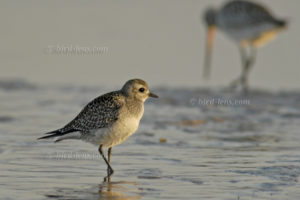 As the morning dawns on an early October day at the Playa de los Lances, west of Tarifa at the southern tip of Spain, only two fighting sanderlings (Calidris alba) con be observed and photographed. Apart from that, there are Common Ringed Plover (Charadrius hiaticula), Kentish Plover (Charadrius alexandrinus), Bar-tailed Godwit (Limosa lapponica), Dunlin (Calidris alpina) and at least one or two Curlew Sandpiper (Calidris ferruginea) in the estuaries of the periodic water courses to take pictures. In addition there are some Black-bellied Plover (Pluvialis squatarola) and one European Golden-Plover (Pluvialis apricaria). Wait a moment!?
As the morning dawns on an early October day at the Playa de los Lances, west of Tarifa at the southern tip of Spain, only two fighting sanderlings (Calidris alba) con be observed and photographed. Apart from that, there are Common Ringed Plover (Charadrius hiaticula), Kentish Plover (Charadrius alexandrinus), Bar-tailed Godwit (Limosa lapponica), Dunlin (Calidris alpina) and at least one or two Curlew Sandpiper (Calidris ferruginea) in the estuaries of the periodic water courses to take pictures. In addition there are some Black-bellied Plover (Pluvialis squatarola) and one European Golden-Plover (Pluvialis apricaria). Wait a moment!?
A Golden Plover here at the tidal seam? This is a very unusual habitat! The golden plover, I have to be suspicious and necessarily see if this was not an American Golden Plover (Pluvialis dominica), possibly even from 29.9 from an Ian Ford and then again from 3.-4.10 as a juvenile copy at Playa de los Lances, Tarifa was seen by David Cuenca Espinosa. And indeed, the exact image analysis actually results in a juvenile American Golden Plover (Pluvialis dominica), which runs along the beach in the first sun. Good to see the large hand primary projection and the protruding feathers over the tail tip tips. The superciliary stripe is also much more contrasty than the “normal” European Golden-Plover.
Stars can be seen on a cloudless sky above me. In the background you enjoy the mountains of Tarifa. The wind from the east has obviously subsided. I decide – like the days before – just before breakfast to go to the beach, park the car on a lot for mobile homes and have a look what passes by. A quick look into the pine trees with the flashlight. No, obviously there is nothing to see. So continue towards Tarifa. Here I park the car at the sports stadium. The view of the beach and the quiet lagoon behind the waterline is just terrific. It’s getting dawn. When I step out of the car neither joggers nor beach strollers are busy around. Only at the water’s edge a few fishermen are waiting from night fishing. I’m heading west to the Rio Jara. I also have to walk almost there to see my first birds. Only in a remnant of the nocturnal flood I see well 15 Sanderlings looking for food. The sun is already visible as a yellow “halo” over the mountain range of Tarifa. The light mood is a real dream. In the far distance I make out a few seagulls. When I get closer, they fly up, but then land very quickly back on the ground. I approach carefully and take a look through the spotting scope. Hey, these are Audouin’s Gull (Ichthyaetus audouinii) that stand here in the middle of a flock consisting of Yellow-legged Gull (Larus michahellis) and a few Lesser Black-backed Gull (Larus fuscus). The Audouin’s Gulls look instantly noticeably daintier, but are with the red beak – almost all adult specimens – very good to see at some distance. In the spotting scope I can count 53 individuals. I start carefully photographing during my approach with increasing brightness of the sun. Finally, even the sun comes over the ridge and throws a warm light on the scenery. Then the Audouin’s Gulls fly away and leave a great impression even when flying.
To cope with the growing demand for top shots of the rarer species of the Palearctic Bird-Lens is keen to enrich the range of pictures of birds you can find in the western Palearctic. Trips to different places like this one to capture images of rare birds of western Palearctic were very successful. The nice images you find in the gallery are only a first impression, what you will find in the gallery in the “Picture Shop” very soon. Just give me a message, if bird-lens.com could serve you with an image needed before the new pictures are online.
Other successful shootings you can see under: www.bird-lens.com in the pictures shop.